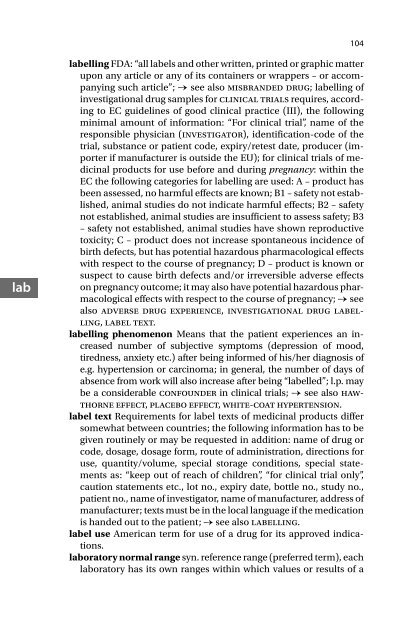220-Dictionary of Pharmaceutical Medicine, 2nd Edition-Gerhard Nahler Annette Mollet-3211898352-S
220-Dictionary of Pharmaceutical Medicine, 2nd Edition-Gerhard Nahler Annette Mollet-3211898352-S
220-Dictionary of Pharmaceutical Medicine, 2nd Edition-Gerhard Nahler Annette Mollet-3211898352-S
Create successful ePaper yourself
Turn your PDF publications into a flip-book with our unique Google optimized e-Paper software.
104lablabelling FDA: “all labels and other written, printed or graphic matterupon any article or any <strong>of</strong> its containers or wrappers – or accompanyingsuch article”; → see also misbranded drug; labelling <strong>of</strong>investigational drug samples for clinical trials requires, accordingto EC guidelines <strong>of</strong> good clinical practice (III), the followingminimal amount <strong>of</strong> information: “For clinical trial”, name <strong>of</strong> theresponsible physician (investigator), identification-code <strong>of</strong> thetrial, substance or patient code, expiry/retest date, producer (importerif manufacturer is outside the EU); for clinical trials <strong>of</strong> medicinalproducts for use before and during pregnancy: within theEC the following categories for labelling are used: A – product hasbeen assessed, no harmful effects are known; B1 – safety not established,animal studies do not indicate harmful effects; B2 – safetynot established, animal studies are insufficient to assess safety; B3– safety not established, animal studies have shown reproductivetoxicity; C – product does not increase spontaneous incidence <strong>of</strong>birth defects, but has potential hazardous pharmacological effectswith respect to the course <strong>of</strong> pregnancy; D – product is known orsuspect to cause birth defects and/or irreversible adverse effectson pregnancy outcome; it may also have potential hazardous pharmacologicaleffects with respect to the course <strong>of</strong> pregnancy; → seealso adverse drug experience, investigational drug labelling,label text.labelling phenomenon Means that the patient experiences an increasednumber <strong>of</strong> subjective symptoms (depression <strong>of</strong> mood,tiredness, anxiety etc.) after being informed <strong>of</strong> his/her diagnosis <strong>of</strong>e.g. hypertension or carcinoma; in general, the number <strong>of</strong> days <strong>of</strong>absence from work will also increase after being “labelled”; l.p. maybe a considerable confounder in clinical trials; → see also hawthorneeffect, placebo effect, white-coat hypertension.label text Requirements for label texts <strong>of</strong> medicinal products differsomewhat between countries; the following information has to begiven routinely or may be requested in addition: name <strong>of</strong> drug orcode, dosage, dosage form, route <strong>of</strong> administration, directions foruse, quantity/volume, special storage conditions, special statementsas: “keep out <strong>of</strong> reach <strong>of</strong> children”, “for clinical trial only”,caution statements etc., lot no., expiry date, bottle no., study no.,patient no., name <strong>of</strong> investigator, name <strong>of</strong> manufacturer, address <strong>of</strong>manufacturer; texts must be in the local language if the medicationis handed out to the patient; → see also labelling.label use American term for use <strong>of</strong> a drug for its approved indications.laboratory normal range syn. reference range (preferred term), eachlaboratory has its own ranges within which values or results <strong>of</strong> a


